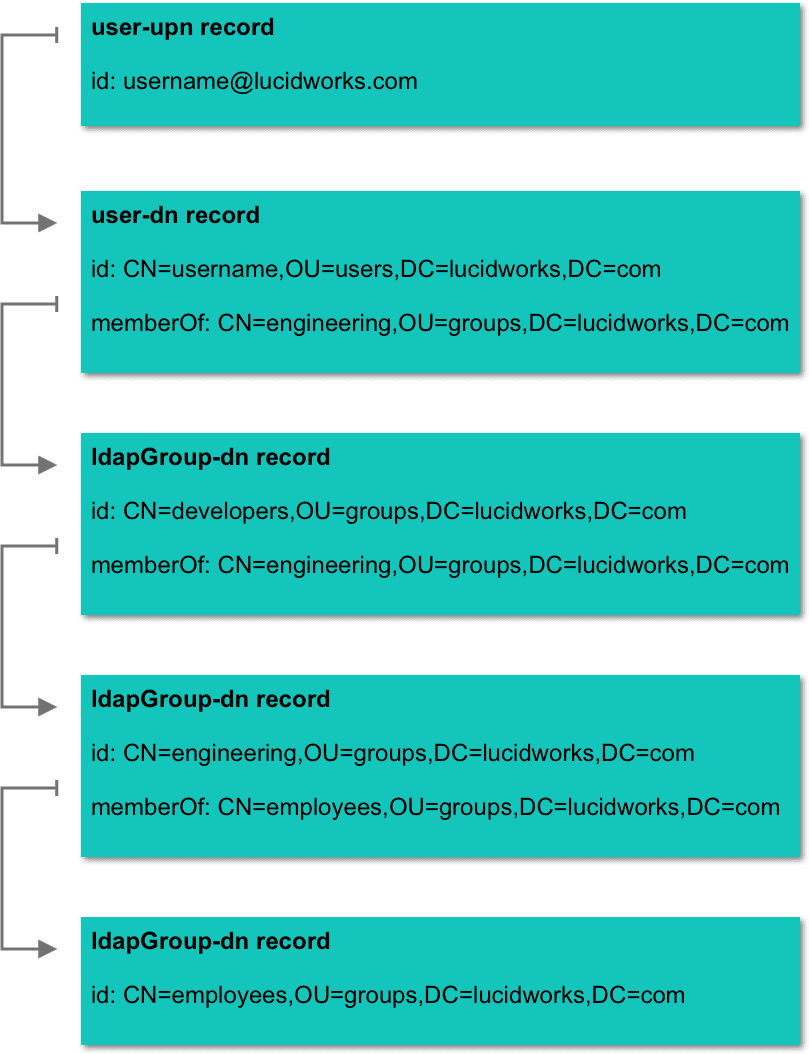This article describes features or functionality that are only compatible with Fusion 4.2.x through Fusion 5.5.2.
Use the Active Directory ACL Collection in Fusion 4.2 (V1)
Use the Active Directory ACL Collection in Fusion 4.2 (V1)
The Active Directory Connector for ACLs indexes Access Control List (ACL) information into a configured “sidecar” Solr collection, so that it can be used by other connectors.During the security trimming stage, the ACL collection is queried using a Solr graph query, which creates a graph of the results using nodes from one document to another.To use the ACL collection, provide the inputs described below when configuring the Active Directory Connector for ACLs:
This article describes how to use an ACL collection generated by the Active Directory Connector for ACLs in V1 platform version.
| Input | Description | Example |
|---|---|---|
| Start Links | Each LDAP or LDAPS URL that is crawled. | ldaps://na.lucidworks.com |
| LDAP User Principal | The user principal account that crawls LDAP. | [email protected] |
| LDAP User Password | The password of the user that crawls LDAP. | Password123 |
| LDAP Search Base | The base DN that performs the crawl. | DC=na,DC=lucidworks,DC=com |
| LDAP User Base (optional) | A list of users that are permitted to access a specific LDAP base. | OU=Users,DC=na,DC=lucidworks,DC=com |
| LDAP Group Base (optional) | A list of groups that are permitted to access a specific LDAP base. | OU=Groups,DC=na,DC=lucidworks,DC=com |
| LDAP User Filter (optional) | A custom attribute filter that finds user records in LDAP. | (&(objectclass=user)(sAMAccountName=*)) |
| LDAP Group Filter (optional) | A custom attribute filter that finds group records in LDAP. | (&(objectclass=group)) |
| SOLR ACL Collection Name | The name of the ACL collection. | acl |
| Index sAMAccountName Users (Active Directory only) | When active, a document is created in the ACL collection representing a user with an ID of sAMAccountName. This allows security trimming on the domain\username version of the username. | true |
| Index userPrincipalName Users (Active Directory only) | When active, a document is created in the ACL collection representing a user with an ID of userPrincipalName. This allows security trimming on the [email protected] version of the username. | false |
This connector is used for security purposes. It does not crawl the Active Directory for data. The output of this connector is not affected by any index profile and will not be visible in queries.
Platform versions
For Fusion 5.1 and later, the Active Directory Connector for ACLs is available in V2 platform version. For detailed information, see AD Connector for ACLs V2 reference. For Fusion 4.2, see AD Connector for ACLs V1 reference.Graph Query
The ACL collection contains a lookup for all users and groups within your LDAP server. This is used by the graph query to span out into all nested group relationships of a certain user. The graph query also allows your security trimming stage to input different forms of a username, including the user’s LDAP DN, domain\username, and[email protected], while still being able to fetch the user’s groups.
To use a graph query, it is essential to understand and adhere to graph query limitations. The graph parser only works in single node Solr installations, or with Solr Cloud collections that use exactly 1 shard. For more information, see the Solr Reference Guide associated with the Fusion release you are running.
Limitations when creating the ACL collection using the graph parser
Graph Query example
Let us say you want to run a security trimmed query for the user[email protected]. This type of username is called a “user principal name” in Active Directory. In order for the security trimming stage to run, it will need to use the following graph query:

fq) to match against a document’s ACL metadata field and ensure the user only sees what they have access to.
The graph query can further traverse the Active Directory field. For example, it can map ldapGroup-dn to ldapGroup-sid, so you can match groups such as S-1-5-21-3623811015-3361044348-30300820-1013. This functionality is especially relevant for SharePoint and SMB2 connectors.
Incremental Crawls
After a crawl has been finished successfully, all subsequent crawls are “incremental crawls”. Incremental crawls are only supported on Active Directory. An incremental crawl uses thewhenChanged attribute in order to fetch only records that have changed since the previous crawl(s). Additionally, the CN=Deleted Objects Active Directory location is queried to identify objects deleted since the last crawl.
Incremental crawls are typically run with a scheduled jobs in order to keep the ACL collection up-to-date. Because the crawls are incremental, these jobs should run very quickly.